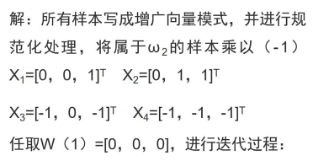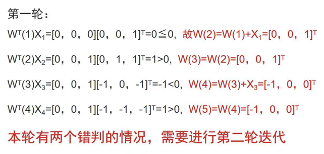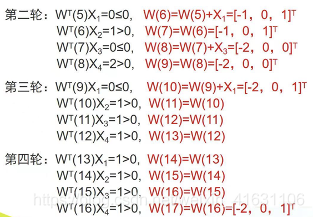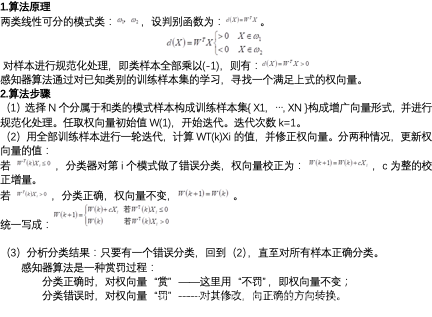Python实现感知器算法 详解怎样用Python实现感知器算法
Julyers 人气:0想了解详解怎样用Python实现感知器算法的相关内容吗,Julyers在本文为您仔细讲解Python实现感知器算法的相关知识和一些Code实例,欢迎阅读和指正,我们先划重点:Python实现感知器算法,Python算法,下面大家一起来学习吧。
一、题目

二、数学求解过程



该轮迭代分类结果全部正确,判别函数为g(x)=-2x1+1
三、感知器算法原理及步骤

四、python代码实现及结果
(1)由数学求解过程可知:

(2)程序运行结果

(3)绘图结果

'''
20210610 Julyer 感知器
'''
import numpy as np
import matplotlib.pyplot as plt
def get_zgxl(xn, a):
'''
获取增广向量
:param x: 数组
:param a: 1或-1
:return:
'''
temp = []
if a == 1:
xn.append(1)
if a == -1:
for i in range(len(xn)):
temp.append(xn[i]*(-1))
temp.append(-1)
xn = temp
# print('xn:'+ str(np.array(x).reshape(-1, 1)))
return np.array(xn).reshape(-1, 1)
def calculate_w(w, xn):
'''
已知xn和初始值,计算w
:param w: 列向量 --> wT:行向量
:param xn: 列向量
:return:
'''
# wT = w.reshape(1, -1) # 列向量转变为行向量,改变w
wT = w.T # 列向量转变为行向量,不改变w
wTx = np.dot(wT, xn).reshape(-1) # 行向量乘以列向量, 维度降为1。
#wTx = wT@xn # 行向量乘以列向量
if wTx > 0:
w_value = w
else:
w_value = np.add(w, xn)
# print("w_update的shape" + str(w_update.shape))
#print("wTx:" + str(wTx))
return w_value, wTx # w_value为列向量, wTx为一个数
def fit_one(w1, x1, x2, x3, x4):
'''
完成一轮迭代,遍历一次数据,更新到w5。
:param w1: 初始值
:param x1:
:param x2:
:param x3:
:param x4:
:return: 返回w5和wTx的列表。
'''
wTx_list = []
update_w = w1
for i in range(0, len(x_data)): #len计算样本个数,通过循环更新w
update_w, wTx = calculate_w(update_w, x_data[i])
wTx_list.append(wTx)
#print(wTx_list)
return update_w, wTx_list
def draw_plot(class1, class2, update_w):
plt.figure()
x_coordinate = []
y_coordinate = []
for i in range(len(class1)):
x_coordinate.append(class1[i][0])
y_coordinate.append(class1[i][1])
plt.scatter(x_coordinate, y_coordinate, color='orange', label='class1')
x_coordinate = []
y_coordinate = []
for i in range(len(class2)):
x_coordinate.append(class2[i][0])
y_coordinate.append(class2[i][1])
plt.scatter(x_coordinate, y_coordinate, color='green', label='class2')
w_reshape = update_w.reshape(-1)
#print
x = np.linspace(0, 2, 5)
if w_reshape[1] == 0:
plt.axvline(x = (-1) * w_reshape[2]/w_reshape[0])
else:
plt.plot(x, (x*w_reshape[0]*(-1) + w_reshape[2]*(-1))/w_reshape[1])
plt.title('result of perception')
plt.xlabel('x1')
plt.ylabel('x2')
plt.legend()
plt.show()
if __name__ == '__main__':
x1 = [0, 0]
x2 = [0, 1]
x3 = [1, 0]
x4 = [1, 1]
class1 = [x1, x2]
class2 = [x3, x4]
x1 = get_zgxl(x1, 1)
x2 = get_zgxl(x2, 1)
x3 = get_zgxl(x3, -1)
x4 = get_zgxl(x4, -1)
x_data = [x1, x2, x3, x4]
# print(x_data)
w1 = np.zeros((3, 1)) # 初始值w1为列向量
#print('w1:' + str(w1) + '\n')
update_w = w1
update_w, wTx_list = fit_one(update_w, x1, x2, x3, x4)
count = 0
iter_number = 0
for wTx in wTx_list:
if wTx > 0:
count += 1
if count < 4:
update_w, wTx_list = fit_one(update_w, x1, x2, x3, x4)
iter_number += 1
else:
break
print('迭代次数为:' + str(iter_number))
print('迭代终止时的w:'+'\n' + str(update_w))
#print(wTx_list)
draw_plot(class1, class2, update_w)
加载全部内容